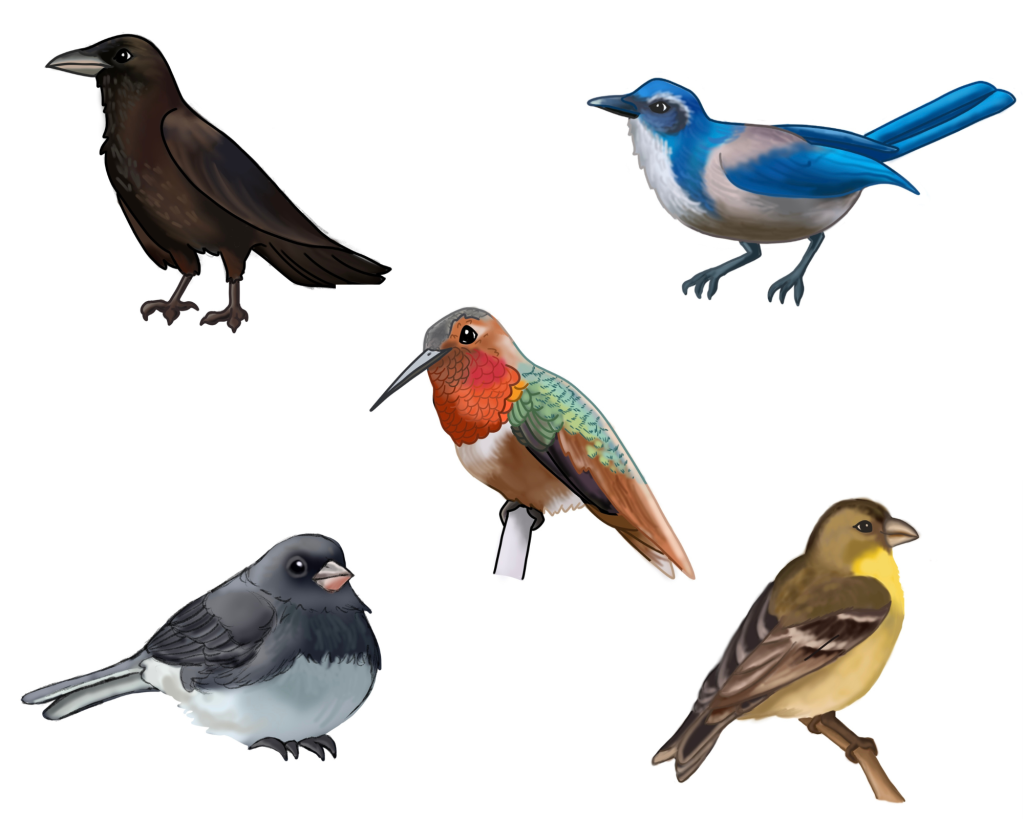Olive Gaetz ’25
Staff Writer
No matter if you’re a freshman or a senior, you may not know your college campus as well as you think you do. Sure, you may know where your classes are, where to pick the tastiest oranges, and you might even be able to name a few kinds of flowers, but how often are you looking up? Claremont is not only home to flocks of students looking to enjoy the beautiful California weather, it’s also the ecosystem of many species of native birds. These creatures of all sizes, shapes, and diets play crucial roles in every ecosystem on the planet, from managing insect and rodent populations to pollinating plants. Despite their incredible contributions to the environment, birds are often overlooked as pests or just uninteresting details of daily life. Knowing who you share an environment with is a crucial part of conservation and can be as simple as learning the names and habits of the feathered friends you run into every day.
Allen’s Hummingbird: Perhaps one of the most distinctive birds out of the lineup, the Allen’s Hummingbird packs a big influence in a little package. Though barely larger than a tube of chapstick, it’s not difficult to spot them zipping around between tree branches and flowers looking for pollen or small insects. My favorite place to look for them is the trees right outside of Toll, it’s a great space to space out and birdwatch for awhile as they tend to chase each other around among the branches. If you get a close enough look, you might even see the beautiful yellow, teal, and vermillion feathers that make the Allen’s Hummingbird unique. Starvation is the main cause of death for hummingbirds so if you’d like to help, consider putting out an artificial feeder or getting involved with campus gardening clubs.
American Crow: Though not a classic Californian beauty, I would be remiss to not include these infamous Scripps residents: the crows. Frequently spotted stealing tortillas from the Malott trash cans or causing a racket in the trees by Seal Court, crows are known for their mischievous nature and intelligence. It’s thought that crows can remember human faces for years and are also capable of using simple tools, so maybe think twice before messing with one on campus or else you may have a crow with a baseball bat knocking on your door. Crows are also helpful in managing the populations of rodents and small reptiles but will often go after human leftovers as well when living in urban areas, so keep an eye on your plate!
Lesser Goldfinch: Pale yellow in hue but just as charming as its American counterpart, the lesser goldfinch is a little dollop of sunshine in a feathery package. Though their yellow feathers are enough to distinguish them from other native songbirds, the lesser goldfinch can also be identified by one of their calls resembling a telegraph beep. Surprisingly, the lesser goldfinch has actually benefited quite a bit from human influence, adapting easily to new habitats and taking advantage of high availability of bird seed to sustain them over the winter. Their populations now span across the West Coast and even down into South America, though Pomona’s Marsden Quad seems to attract quite a few of them with the plentiful seeds and tall trees.
California Scrub Jay: If you’ve ever seen a flash of blue feathers in your periphery, you may automatically assume it to be a blue jay or bluebird if you’re not from the West Coast. The California scrub jay is very similar in color to these other two species but has much more widespread splotches of white on its belly and chin. The Birds of the World database describes them as “bold and confident” which is quite fitting as they have easily adapted to urban environments and are seemingly barely affected by human activity at all. Scrub jays are most active in the morning and late afternoon and will forage for fruit, arthropods, and seeds, making that the best time to venture out of your dorm to try and find one.
Dark-Eyed Junco: Finally, a personal favorite of mine, the dark-eyed junco is a very common bird in Claremont that I never knew the name for. Depending on the season, juncos can be found all across the United States and is actually one of the most common “passerines” (perching birds) in the country. Juncos can be spotted by their slate grey feathers with a circular patch of white on their belly and are often very round little birds. If you’re out and about, you should keep an ear out for one of their calls that sounds somewhat like a car alarm: a series of quick, high-pitched tweets. The best fact about the junco, however, is their nickname “snow bird.” Thought to be messengers of winter, seeing a junco is supposedly a sign that winter is on its way as they migrate across the country which will hopefully ring true for Claremont as well.
Image Source: Olive Gaetz ’25



